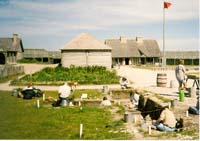The
Archaeology of America's Colonial Wars
David R. Starbuck

Digging in the heart of the reconstructed post of Michilimackinac. The excavation of the east end of the South Southwest Row House, shown here, began in 1998.
Every child fantasizes occasionally about becoming a soldier and accomplishing great deeds in battle. Or at least I did. After all, armies and the fortifications they occupy have helped to determine the destiny of nations, and the modern cultures, languages, and worldviews of the North American continent were shaped during the colonial wars of the seventeenth and eighteenth centuries. As children, we are exposed to mind-numbing lists of dates for battles, victories, and treaties, along with the names of forts, generals, and patriotic heroes, all of which seem very remote from us. But as adults we come to realize the significance of those distant events in shaping our modern regional, national, and ethnic identities, and then we discover that the sites of long-ago battles can still be visited. Hundreds of forts and battlefields have been excavated, interpreted, and oftentimes reconstructed, and millions of visitors each year are able to appreciate how very near to them the past can be.
Most of these military reconstructions and open-air interpretations required archaeologists to put in years of archival research, excavation, and artifact analysis. Many of the early engineers' drawings of forts and battlefields are highly schematicized or incomplete, with ordinary soldiers' huts, lookout posts, and latrines rarely depicted, and with many details not drawn to scale. The surviving construction plans for forts were typically drawn before laborers began to build the walls, and thus French, British and Spanish forts that have been reconstructed without the use of archaeology tend to be woefully inaccurate.
Military sites archaeology is unquestionably one of the most popular and dynamic subfields of historical archaeology, attracting millions of annual visitors to reconstructed sites. No doubt this level of interest is due to the dramatic, even catastrophic, events that occurred at many military sites, and these were certainly seminal in shaping the direction of the nations that formed in North America. But past glories or disasters on the battlefield or ramparts are not the greatest thrill for the archaeologist: rather, the real excitement comes from examining the lives of soldiers and officers who have not had a voice until now, yet who left us with a rich record of hut outlines and fireplaces, latrines, garbage-filled wells, wine bottles, exploded mortar shells, armament, and more. These are the pieces from which we can reconstruct a bit of their humanity, and perhaps our research will help to honor the early soldiers who made sacrifices under extremely harsh frontier conditions.
Featured Projects
- Fortress of Louisbourg, Nova Scotia - Lu Ann De Cunzo
- The author discusses the fortress's history, with the historical play-acting that takes place each year during the spring. More than thirty-five years of archaeological research have made possible this world-class heritage experience.
- Colonial Michilimackinac, Michigan - Lu Ann De Cunzo
- This is the fortified settlement built by the French in the early 1700s to protect the French Fur trade in the region. Each year, an archaeological team returns to the site to excavate while visitors watch as the past gets uncovered before their eyes.
About the Contributor:
Lu Ann De Cunzo is Associate Professor of Anthropology at the University of Delaware.
